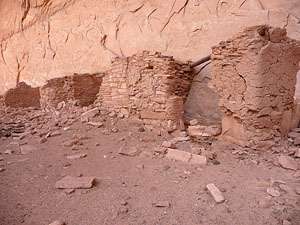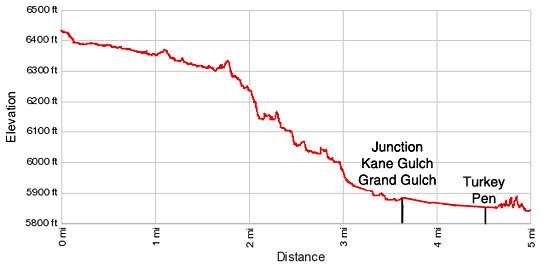Details: Kane Gulch to Junction and Turkey Pen Ruins 
Distance: 7.0 - 9.7 miles (round trip)
Grand Gulch Primitive Area, BLM, Monticello, Utah office, near Grand Gulch in Southeast Utah
Hike Facts
- Distance: 7.0 - 9.7 miles (round trip)
- Elevation: 6,440-ft. - 5,850-ft.
- Elevation Gain: -590-ft.
- Difficulty: moderate
- Trail Highlights: See Trail Intro
- Basecamp(s): Grand Gulch / Blanding
- Region: Southeast Utah

Grand Gulch is often likened to an open air museum of Ancestral Puebloan ruins and rock art. This trail offers a great introduction to the canyon, visiting Junction Ruin and Turkey Pen Ruin and passing a nice viewpoint for Stimper Arch.
To Junction Ruin

Distance from Trailhead: 7.0 miles (round trip)
Ending/Highest Elevation: 5,910-ft.
Elevation Gain: -530-ft.
The trail down Kane Gulch starts across from the Kane Gulch Ranger Station on the west side of UT-261 (see driving directions below). Follow the trail as it crosses a scrub covered bench and then drops into Kane Gulch at 0.1 miles. The gulch is nothing more than a shallow draw at this point.
The trail now weaves its way through two willow thickets and crosses a scrub covered bench before arriving at a gate at 0.4 miles. Be sure to close the gate behind you. Past the gate the trail travels along a slickrock clad section of the wash.
Follow the trail as it continues down canyon on easy grades. As you progress, Kane Gulch starts to look more like a canyon with low, white sandstone walls.
At 1.8 miles the trail begins a moderately steep descent down rock slopes and slickrock ledges along the right (northwest) side of the canyon. Shortly after pass a sign marking the beginning of the Grand Gulch Wilderness Study area reach to top of a pour-off at 2.0 miles.
The trail bypasses the pour-off on the right (north/northwest). A short distance beyond the pour-off the path travels along a slickrock clad section of the wash before resuming its steep to moderately-steep descent down rock slopes and ledges along the right (north/northwest) side of the canyon. Looking down you will see sections of the wash clogged with massive boulders.
At 2.4 miles rock cairns mark the trail as it contours along a ledges and then drops down a rocky slope to the top of a pour-off. The trail crosses the top of the pour-off and then descends the slopes on the left (south) side of the canyon.
Past the pour-off the grade abates. The trail now drops down the canyon on moderate to easy grades. As you descend, watch for rock cairns marking where the trail crosses the wash to the opposite bench. Kane Gulch is now quite scenic, with multihued sandstone walls stained with desert varnish towering above the wash. During a typical year pools of water will start appearing in the wash about 3.0 miles down canyon.
At 3.3 miles the trail curves to the west and continues descending on easy grades to the confluence of Kane Gulch with Grand Gulch at 3.7 miles. Nice campsites are spread amid the large Cottonwood trees that shade the junction of two canyons. Water emanating from Junction Spring, located a short distance up the Kane Gulch, typically fill pools in the lower end of the Kane Gulch Wash in the spring. Check at the Kane Gulch Ranger Station to get an update on water availability in Kane Gulch and at the “Junction”.
Walk about 0.2 miles up Grand Gulch to find Junction Ruin. This extensive set of ruins is built on three levels of an east/southeast facing alcove along the canyon’s west wall. The interesting complex consists of storage units, habitation rooms, kivas, cists (burial chambers) and defensive structures. The construction techniques include wet and dry laid adobe masonry and wattle and daub (mud plaster laid over a matrix of sticks). The ruins were stabilized in 1966 and 1984.
In the main part of the ruin are grinding stones (manos). Grooves cut into nearby stones may have been used to sharpen tools.
In front and below the structure is the midden (trash dump) that is cordoned off to prevent people from walking through the area. Foot traffic contributes to the erosion of the midden and also the loss and exposure of artifacts contained in the midden. Please respect the closure.
The standing walls of the ancient structures are easily damaged. When exploring the ruin please do not climb or lean on the walls and do not enter the rooms. Do not touch the ruins or the rock art. Leave any artifacts you discover in place.
To Turkey Pen Ruin

Distance from Trailhead: 9.0 miles (round trip)
Ending/Highest Elevation: 5,870-ft.
Elevation Gain: -570-ft.
After you are done exploring Junction Ruin walk back through the camping are and find the trail traveling down canyon along the bench on the west side of the wash. At 4.0 miles the trail cross to the wash and curves to the southwest. The boot beaten path will cut back and forth across the wash, traveling along the adjacent benches to cut off meanders and avoid walking in the sandy creek bed.
At 4.4 miles the trail curves to the west. Soon after rounding the corner you will see a deep south-facing alcove along the right (north) side of the trail. On a high ledge in the back of the alcove are some ruins. This is the Turkey Pen Ruin at 4.5 miles. Look for a use trail climbing steeply up the slope on the right (north) side of the canyon to the alcove.
The alcove contains a number of structures along with some pictographs. As you walk through the alcove please respect the chains the blocking off portions of the site. At the eastern end of the alcove chains protect a kiva that is mostly filled with sand. Toward the western end of the alcove is the “turkey pen,” where branches from willows or some other type of thin reed are placed in a circle to create a cage of sorts. The far western end of the alcove is blocked with chains and is not accessible.
To Unnamed Ruin

Distance from Trailhead: 9.7 miles (round trip)
Ending/Highest Elevation: 5,850-ft.
Elevation Gain: -590-ft.
After investigating Turkey Pen continue down canyon for 0.2 miles to see Stimper Arch, located high on a ridge jutting into the canyon from the east. Many people turn around a Stimper and retrace their steps to the trailhead. If time and energy permits continue down canyon to visit one more ruin within day hiking distance of Kane Gulch Ranger Station.
Beyond the viewpoint for the arch the trail curves to the south and then back to the west. As you head west, watch for a use trail heading right (north) toward an alcove along the base of the canyon wall at 4.9 miles. The alcove is partially obscured by large Cottonwood trees and brush.
The alcove contains quite a few structures in poor condition. It looks as though floods periodically sweep through the alcove. Many of the ruins have collapsed walls and caved-in roofs. Amazing a few of the structures still have remnants of stuccos that coated the exterior walls. At the east end of the alcove is a fascinating rock art panel with pictographs and petroglyphs. Some of the petroglyphs were outlined in white after they were chiseled into the rock. The BLM has erected chains around portions of the site. Please respect these closures. The rock art and the ruins are very fragile.
This is a great turn around point for a 10+ mile round trip day hike (including side trips exploring the ruins). Remember the return journey is all uphill, during the warm part of the day. Much of the walk up the canyon is exposed to the full brunt of the afternoon sun. Be sure to care plenty of water and take some sun protection.
A note about visiting archaeology sites:
Grand Gulch was occupied by Ancestral Puebloan Native Americans between 800 and 2,000 years ago. Ruins from this period may be found built in protected areas such as under overhangs and in alcoves in the cliffs. Their rock art decorates cliff faces and protected alcoves.
Unfortunately this fascinating record of the past is threatened. The unintentional damage caused by visitors is slowly destroying the remnants of the ancient culture. These resources are nonrenewable. Before entering an archeological site, take a few moments to plan your "exploration strategy" to ensure that your visit results in a minimum impact.
Climbing on roofs and walls can destroy in a moment what has lasted for hundreds of years. Do not lean on or climb on walls or roofs or enter any rooms. Please respect all chain barriers. Use extra care around plastered walls. Leave your backpack outside of the site. A bump with a backpack can easily break or chip the plaster.
When you see potsherds and other artifacts leave them where they are. If each visitor took just one, there would soon be none left. Putting them into piles for display takes them out of context, exposes them to weather, and destroys clues needed by professional archeologists gathering information about the site. Please do not reuse prehistoric grinding stones or surfaces.
Enjoy rock art by viewing, sketching, and photographing it. Never chalk, trace, or otherwise touch rock art. Any kind of direct contact causes these ancient figures to disintegrate. Do not add your name or any other modern day rock art.
Please stay out of the trash! A midden is a trash pile left by the original occupants of the site. It is usually recognized by darkened soil and perhaps a slightly raised area in front of the site. Do not walk through the midden. This can destroy valuable archeological information and causes erosion which may undermine the walls of the structures above it. If a trail has been built across a site, stay on it. Please respect any area marked as closed to entry, or physically closed to entry.
Take only pictures, and leave only footprints.
Day Hiking and Backpacking Permits for Cedar Mesa
Please note: Permits are required for hiking and backpacking in the canyons of Cedar Mesa, including Grand Gulch. Day use permits may be obtained at the Kane Gulch Ranger Station or at trailheads. During the spring and fall, overnight backpacking permits are only available at the Kane Gulch Ranger Station, and must be obtained on the morning of the trip. They may be reserved up to 90 days in advance by calling 435-587-1510. During other seasons, these permits may be obtained from the Monticello Field Office. See the BLM Grand Gulch website for more information.
Elevation Profile

Driving Directions
From Blanding: Drive south on US 191 S for 4 miles and turn right (west) on UT-95 N. Follow UT-95 for 28.4 miles and turn left (south) on UT-261 S. Head south on UT 261 for 9.7 miles to the Kane Gulch Ranger Station, located on the left (east) side of the road. Park in designated hiker parking area, located on the north side of the visitor center.
From Mexican Hat: Head north on US-163 for 3.9 miles and turn left (north) on UT-261 N. Follow UT-261 north for 28.8 miles and turn right (east) into the Kane Gulch Ranger Station. Park in the hiker’s parking area, located on the north side of the visitor center. Note: a short section of UT-261 climbs steep gravel switchbacks up the Moki Dugway.
Trail Resources
Trail Intro / Trail Photo Gallery / Trail Map
Basecamp(s) Information:
Grand Gulch / Blanding
Region Information:
Southeast Utah
Other Hiking Regions in:
Utah